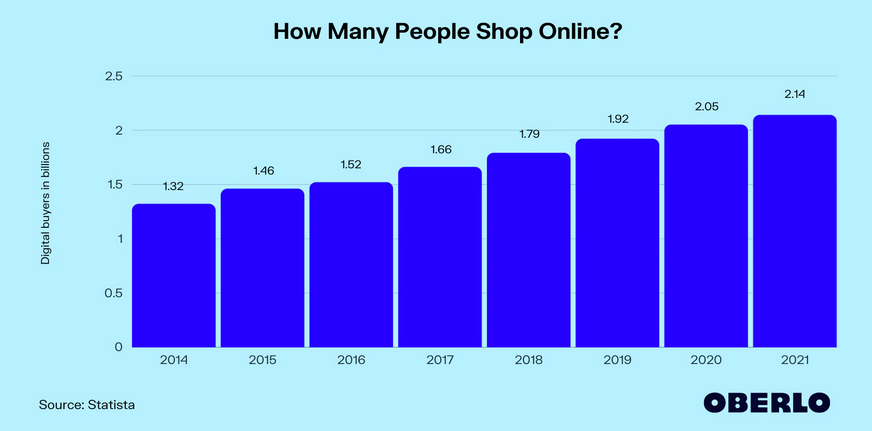
E-commerce: a bargain of a vertical
E-commerce is one of the so-called evergreen affiliate verticals. It covers promoting tangible goods via the Internet. E-commerce means convenience for the users, so naturally, it is always attractive as it’s in human nature to save efforts where possible. Over the years credit cards and online payment systems have made it easy to shop online, and the 2020 pandemic has also contributed to the soaring rise of e-commerce brands as the world’s population has been forced to stay indoors for months at a time. Online shopping has become as easy and accessible as turning on a computer, and this is the reason why vast audiences choose it over traditional in-store purchases.
Let’s take a closer look and try to figure out what makes e-commerce so popular.
What’s on offer?

E-commerce vertical deals with tangible goods, this means that among the advertisers you would mostly find online stores and brands of varying sizes that strive to build an online presence. Absolutely anything people want to buy can be promoted online from classy suits and Teddy bears to the latest iPhone or a Mercedes car. We often see undying trends like weight-loss supplements, a huge variety of small gadgets like earphones and portable chargers. As an affiliate you do not have to worry about storage, packaging, and shipping — your task is to promote the goods, the rest is dealt with on the advertiser’s side.
The e-commerce offers are mostly PPS (pay-per-sale), PPL (pay-per-lead), PPC (pay-per-click), or RevShare. In any case, the major focus should be on the quality of the audience, as the main goal is to finalize the sale of goods.
In search of an audience

This vertical is a mainstream one, so the traffic sources you would look for are mainly social media platforms, search traffic, native traffic. One of the best platforms for e-commerce campaigns is Facebook. The algorithm on this social network actually helps you promote goods if it believes that the audience would benefit from it. Instagram has long become a haven for small online stores, these are mostly run by the brand-owners, and the competition is rather high. Dynamic video media like TikTok are great for unusual products or fresh trends as you have to present unique content to get noticed out there. At the same time, TikTok is a major source of fashion trends nowadays, considering this it is worth a shot for any e-commerce campaign. And also, such websites as Shopify and Pinterest definitely deserve a place on the list of best e-commerce traffic sources. These platforms are gaining traction in the online shopping industry.
Native advertising is another channel that works well for e-commerce campaigns. These ads are unobtrusive and are really good at fighting ad fatigue among your audience. As native ads are seamlessly embedded into the themed content, they attract quality leads that are already interested in the topic. This is why native advertising tends to have a higher CTR.
Shopping season all year round
Strictly speaking, there is no such thing as a non-shopping time on the Internet. There are seasonal goods and limited promotions, but apart from that goods are sold and purchased every day and every hour.
Yet still, some periods are especially profitable for e-commerce campaigns — times of shopping sprees. We are talking about the end-of-year Christmas shopping, Black Friday, Cyber Monday, and any other annual shopping event that is out there. Such periods are a good time for a scheduled re-launch of a successful campaign. Christmas happens every year, why not benefit from it?
Work on your value proposition

In order to sell anything, you have to tell the audience why the thing you are promoting is worth buying. To do that, invest your effort in quality landers and pre-landers. Make them easy to read and state the value point clearly. Also, think of UGC (user-generated-content) creatives for your landing pages: a testimonials section with reviews and unboxing works miracles in convincing the undecided shoppers.
Always optimize your campaigns for mobile devices. A huge share of online shoppers loves to spend their time browsing for the goods they need via a smartphone.

Bring the cart abandoners back. Use retargeting campaigns to convert the leads that will be lost otherwise. The best way for doing it is email lists. But be sure to combine the offer with valuable content that would make your letters worth reading from the customer’s point of view.
It will also be a good idea to know the approaches and ad types your fellow affiliates use. This does not mean copying, just watching out for new trends and changes. To do that, you will have to use a spy-tool: these are numerous (e. g. AdPlexity, SEMrush, AdBeat, etc), just pick the one you like best. You can find out more about spying in the 4th episode of our YepCast. Another way to stay tuned for the trends is Facebook Ad Library, a tool for ad transparency across multiple platforms.
Is sells — you earn
E-commerce has been around as long as the Internet itself and it only gains popularity over time. The competition in this niche is tough, but it is still worth giving it a try, especially with the growing demand for convenient shopping from the comfort of one’s home. The main points are to have an in-depth knowledge of the product and the target audience and to choose the right offer, of course. And the Yep Ads team will always be there to lend a hand when you need it.
_________

